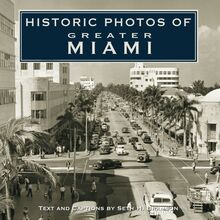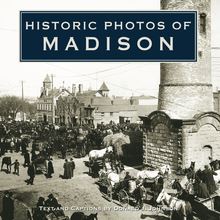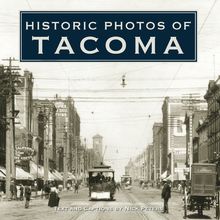Historic Photos of Nashville in the 50s, 60s, and 70s , livre ebook
182
pages
English
Ebooks
2009
Vous pourrez modifier la taille du texte de cet ouvrage
Obtenez un accès à la bibliothèque pour le consulter en ligne En savoir plus
Découvre YouScribe en t'inscrivant gratuitement
Découvre YouScribe en t'inscrivant gratuitement
182
pages
English
Ebooks
2009
Vous pourrez modifier la taille du texte de cet ouvrage
Obtenez un accès à la bibliothèque pour le consulter en ligne En savoir plus
Publié par
Date de parution
01 novembre 2009
Nombre de lectures
0
EAN13
9781618584106
Langue
English
Poids de l'ouvrage
39 Mo
In a nation reinventing itself following victory in World War II, Nashville’s self-portrait blended old with new. New businesses and skyscrapers, a shopping mall, the Interstate system, school integration, and other changes would ultimately bring Nashville into line with the direction of the nation at large, but alongside nationwide trends were treasures unique to the city: Fair Park for thrill-seekers, Sulphur Dell for baseball fans, the Grand Ole Opry at the Ryman for music, and the Maxwell House for visitors still arriving through Union Station and now from the air at Berry Field.
In this companion volume to Historic Photos of Nashville, Ashley Driggs Haugen leads a tour past many Nashville landmarks from the recent past, reminiscing with Nashvillians who can remember and informing those new to the city who may not. Nearly 200 images reproduced in vivid black-and-white show the Opry at the Ryman, construction of the L&C Tower, 100 Oaks Mall, the Municipal Auditorium, Harveys Department Store downtown, and countless other subjects from yesteryear that remain key to the city’s past and present.
Publié par
Date de parution
01 novembre 2009
Nombre de lectures
0
EAN13
9781618584106
Langue
English
Poids de l'ouvrage
39 Mo
HISTORIC PHOTOS OF
NASHVILLE
IN THE 50 S , 60 S , AND 70 S
T EXT AND C APTIONS BY A SHLEY D RIGGS H AUGEN
An aerial view of downtown Nashville. At the top of the photograph is the new L C Tower. Visible at bottom are Union Station and the train yard. With the Train Shed (at bottom right), the station in profile reminded imaginative onlookers of an engine with its train.
HISTORIC PHOTOS OF
NASHVILLE
IN THE 50 S , 60 S , AND 70 S
Turner Publishing Company
200 4th Avenue North Suite 950
Nashville, Tennessee 37219
(615) 255-2665
www.turnerpublishing.com
Historic Photos of Nashville in the 50s, 60s, and 70s
Copyright 2009 Turner Publishing Company
All rights reserved.
This book or any part thereof may not be reproduced or transmitted in any form or by any means, electronic or mechanical, including photocopying, recording, or by any information storage and retrieval system, without permission in writing from the publisher.
Library of Congress Control Number: 2009922629
ISBN: 978-1-59652-539-9
Printed in China
09 10 11 12 13 14 15 16-0 9 8 7 6 5 4 3 2 1
C ONTENTS
A CKNOWLEDGMENTS
P REFACE
A FTER THE W AR (1946-1959)
P OISED FOR G ROWTH AND C HANGE (1960-1969)
T OWARD THE F UTURE (1970 S )
N OTES ON THE P HOTOGRAPHS
Bluegrass legend Bill Monroe is shown here at the Opry in the 1970s. Often venerated as the Father of Bluegrass, Monroe joined the Grand Ole Opry in 1939.
A CKNOWLEDGMENTS
This volume, Historic Photos of Nashville in the 50s, 60s, and 70s , is the result of the cooperation and efforts of many individuals and organizations. It is with great thanks that we acknowledge the valuable contribution of the following for their generous support:
Brenda Colladay, Museum and Photograph Curator, Grand Ole Opry
Deborah Oeser Cox, Metro Davidson County Archives
Chip Curley, Nashville history enthusiast
Ken Fieth, Metro Archivist
Leila Grossman, Owner, Grannis Photography
Aubrey B. Harwell, Jr., Chief Manager, Neal Harwell, PLC
Bill Lundy
Special Collections Division of the Nashville Public Library
Jimmie and Elizabeth Stevens
-------
Prints of images appearing in this publication can be purchased by visiting the Grannis Photography Web site at
www.grannisphotography.com
P REFACE
In the footsteps of the wildly popular Historic Photos of Nashville , we present Historic Photos of Nashville in the 50s, 60s, and 70s , a continuation of the pictorial journey of this great southern metropolis. The photographs presented on the following pages come exclusively from the archives of longtime Nashville photographer Bob Grannis of Grannis Photography. His collection is still highly regarded as an intriguing and appreciative look at all that was Nashville in the decades most directly shaped by the watershed events of World War II.
These photographs were selected from thousands of Grannis s negatives, all of which have been carefully preserved by Leila Grossman, who purchased Grannis Photography in 1997. The photos selected for inclusion in this book represent Nashville in the truest sense, as a city that rode the postwar high in the fifties, weathered the political, social, and cultural changes of the sixties, and eventually settled into the seventies as a rapidly growing and expanding metropolis.
The images, which span the postwar era up to the late 1970s, showcase Nashville during its most developmentally vulnerable period. As the city emerged following World War II, her citizens were eager for good things they hoped would come-and nothing seemed impossible! In the 1950s, downtown Nashville flourished, relishing its role as the go-to spot for shopping, dining, and leisure activities. For school kids, the Children s Museum in the Peabody Building on Rutledge Hill, with its O-gauge model railroad, mysterious grand pendulum pacing the foyer, and two shrunken heads lining the balustrade of a creaky wooden staircase, was not to be missed. The decade was a storybook time that held an almost tangible air of confidence.
In the late 1950s and 1960s, the consolidation of government, desegregation, the building of the Interstate system, and relaxing of the blue laws brought significant political, cultural, and social shifts. Nashville was seeking to shed its Old South image in favor of something deemed more sophisticated. By the 1970s, downtown prosperity had begun to subside as Nashvillians left in droves for the suburbs and urban restructuring kicked into high gear. One harbinger of what was to come was 100 Oaks Mall off Powell Avenue beside Thompson Lane, erected so quickly that shoppers treading its shuddering floors wondered aloud whether it might collapse. This shoppers mecca proved so popular that malls began sprouting up in outlying areas citywide. Nashville as its citizens had known it, was becoming a thing of the past.
Nashville s history is rich, and its more recent history is arguably the most interesting. A lot happened in three decades, and the images on the following pages are evidence of those changes. Mr. Grannis s photographic documentation of all that occurred during these volatile years is a treasure trove for all who love Nashville. His photographic eye undeniably captured the city like no one else, and his images tell the city s story quite poignantly all by themselves. Look closely at each photograph and the not-so-distant history captured in each one. Perhaps you will recognize some of the places and faces. You will likely recollect a time way back when. More than anything, perhaps you will experience both a memory and a smile.
- Ashley Driggs Haugen
A bird s-eye view of the L C Tower, Nashville s first modern skyscraper. In the foreground at right, the Sudekum Building at 535 Church Street stood tall as Nashville s leading example of Art Deco architecture. The building was razed in 1992 behind a sign that announced, If it was built, we ll wreck it.
A FTER THE W AR
(1946-1959)
Following World War II, Nashville enjoyed a postwar boom. The general mood was that of celebration- If we can triumph in a world war, we can conquer anything! People were buying houses and cars, and higher education was becoming a possibility and a priority. Americans who once had thought they could never afford college were now attending universities on the GI Bill. In the Athens of the South, they attended David Lipscomb College, Watkins Institute, Belmont College, and Vanderbilt University, among others.
Five-and-dimes, department stores, and luncheonettes flourished in the downtown area. Among them was Varallos chili parlor, which would celebrate its 100th anniversary in 2007 as Nashville s oldest eatery. It was during the 1950s that the Capitol underwent the first of two restorations, and the L C Tower was erected, claiming the title as the tallest skyscraper in the Southeast, at least for a time. Families dressed up for a drive downtown, whether to shop, dine, or simply to take in the sights.
The 1950s were also the defining decade for Nashville s music industry. The city was officially ordained Music City USA, and the opening of numerous recording studios and record labels helped mold 16th and 17th avenues into what is now the world-famous Music Row. The Country Music Association was founded, and the Grand Ole Opry had comfortably settled into its home at the Ryman Auditorium, where it remained until moving to Opryland in 1974. By the 1960s, the connection between Nashville and music had been made. When local TV s Miss Nancy, host of Romper Room, asked one youngster where she lived, the tongue-tied youth couldn t think Nashville, so she replied Music City USA.
Whether attending parades, hanging out at Fair Park, or simply watching a Nashville Vols game at Sulphur Dell, Nashvillians were enjoying the good life. The city was thriving, and its people enjoyed being a part of it.
A celebration commemorating the sesquicentennial of Tennessee in June 1946 was attended by hundreds. Military vehicles paraded in front of War Memorial Plaza on Capitol Boulevard. A United States commemorative stamp was issued in observance of the milestone.
Harding Road facing south toward today s Highway 100-70 fork. The road now carries four lanes of traffic, and the businesses pictured are long since gone. The building housing the Gulf Station at right is today home to Global Motorsports auto dealership, and not too far away is Nashville s time-honored toy store, Phillips Toy Mart. The nation s worst railroad accident occurred in 1918 along this Nashville-to-Memphis railroad line at Dutchman s Curve, a mile or two northeast of the area in view here.
Fourth Avenue South facing north toward Broadway, around 1947. Businesses in view include Hardison Seed in the foreground, and in the distance, Third National Bank.
A rainsoaked day at Five Points in East Nashville. Forrest Avenue is on the right. At left, Bill s Cafe serves Gerst beer, a longtime Nashville favorite brewed locally up to 1954.
An East Nashville neighborhood. From the great fire of 1916 to the tornado of 1998, the city s east side has weathered its share of natural disasters, yet has managed to preserve the charm of its historic neighborhoods.
Vanderbilt fans enjoy a pep rally before a game sometime in the 1940s.
At this 1940s Vanderbilt football game, players still wore leather headgear.
A wintry day left Nashville covered in snow. This photograph shows West End Avenue, facing downtown. The white stone bungalow at center is the only structure in view still standing today, and it is believed the arboreal elders that still nod quietly to every alert motorist are the same magnolia trees visible in the front yard here.
The scene at the corner of Eighth Avenue and Lafayette Street on a day in the 1950s. To this day, Nashvillians do not agree on how to pronounce Lafayette, which becomes Highway 41 on its way to Murfreesboro, Chattanooga, and eventually, Florida. To the right, Eighth Avenue becomes Highway 31 (Franklin














